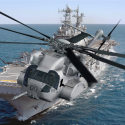TrackingPoint Announces Military Squad-Level Precision-Guided Firearms
New Products Expected to Provide Insurmountable Squad Overmatch Capability.
Offerings Include M600 SR Service Rifle and M800 DMR Designated Marksman Rifle.
Company Offers Ten Zero-Cost Systems to Any Organization that can take the Guns into the Fight Against ISIS.
Pflugerville, Texas (November 4, 2015) – TrackingPoint’s new Squad-Level Precision-Firearms (SQLPFs) are designed to change the face of war. The M600 SR 5.56 NATO service rifle and M800 DMR 7.62 NATO designated marksmen rifle utilize TrackingPoint’s new RapidLok™ Target Elimination Fire Control system to automatically acquire and eliminate enemy combatants.
“We firmly believe that the M600 SR and M800 DMR will save countless lives and enable our soldiers to dominate enemy combatants including terrorists,” said John McHale, TrackingPoint CEO. The company is offering ten free M600 SRs or M800 DMRs to any U.S. organization that can legally bring them to the Middle-East in the fight against ISIS and Al Qaeda. “It’s hard to sit back and watch what is happening over there. We want to do our part. Ten guns don’t sound like a lot but the dramatic leap in lethality is a great force multiplier. Those ten guns will feel like two hundred to the enemy,” said McHale.
According to retired Colonel Tommy Gilmore TrackingPoint’s Squad-Level Precision Fire weapons will provide a significant overmatch advantage. "The modern battlefield is a dynamic, confusing, and very lethal environment. We have seen extraordinary advances in major weapon systems development. Now we see with the TrackingPoint precision-guided M600 SR and M800 DMR a force multiplier and a major step forward for the individual soldier, sailor, airmen, and marine. I have shot several TrackingPoint PGFs, in fact I own one, and can say without reservation the TrackingPoint PGFs are by far the most lethal and accurate small-arms weapons platform ever designed and produced,” said Gilmore.
M600 SR – NATO 5.56
Designed to replace the M4A1, the M600 SR delivers an 87% First-Shot-Success-Probability out to 600 yards regardless of shooter experience or skill. This is approximately 30 times the first-shot kill-rate for the typical soldier behind an M4A1. The M600 SR can eliminate targets moving as fast as 15MPH.
M800 DMR – NATO 7.62
Designed to replace the M110 and M14, the M800 DMR delivers an 89% First-Shot-Success-Probability out to 800 yards. According to the Army’s own data (Whitefeather study, 1999) this result is approximately 33 times the first-shot kill rate of today’s operational snipers. The M800 DMR can eliminate targets moving as fast as 20MPH.
RapidLok™ Target Elimination Fire Control System
As a soldier pulls the trigger the enemy is automatically acquired and tracked. When trigger pull completes, the target is instantly eliminated. Total Time-To-Kill (TTK) is approximately 2.5 seconds for the M600 SR and M800 DMR. RapidLok™ Fire Control is image stabilized enabling fighters to make off-hand shots as if they are shooting supported. RapidLok™ has an auto-snap feature that automatically adjusts point-of-impact to target center of mass. Also, target velocity is instantly measured and contemplated in the launch solution. RapidLok incorporates a laser-based Barrel Reference System that ensures shot-to-shot perfect zero eliminating error from shock, vibration, or environmental changes such as temperature, humidity, and barometric pressure.
Zero-Signature Lethality
The M600 SR and M800 DMR stream video to TrackingPoint’s ShotGlass™ wearable glasses. The soldier can see the battlefield without putting his head behind the gun, and is completely unexposed and can see and eliminate targets as if he were looking in the scope. Soldiers can shoot over berms and around corners with an extremely high hit rate on moving targets at long distances.
Availability and Pricing
The M600 SR ($9995) and M800 DMR ($15,995)will begin shipping on December 5th to the United States Military, United States organizations that can bring the guns into the fight against terrorism legally, and qualified United States citizens. Taya Kyle will be using the M600 SR and M800 DMR in the American Sniper Shootout December 5th in Mason, Texas.
About TrackingPoint
TrackingPoint, based in Austin, Texas, created the first Precision-Guided Firearm, a revolutionary new shooting system that puts fighter jet lock-and-launch technology in small arms, enabling shooters to make shots previously considered beyond human ability. To learn more, visit.
# # # # #
Media Contact:
Kimberly Chung
TrackingPoint
512-220-5196
[email protected]

